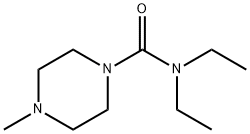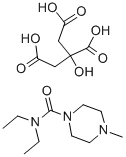A4715731
Diethylcarbamazine , 97% , 90-89-1
CAS NO.:90-89-1
Empirical Formula: C10H21N3O
Molecular Weight: 199.29
MDL number: MFCD00023288
EINECS: 202-023-3
| Pack Size | Price | Stock | Quantity |
| 250mg | RMB100.00 | In Stock |
|
| 1g | RMB250.40 | In Stock |
|
| 5g | RMB631.20 | In Stock |
|
| 25g | RMB2031.20 | In Stock |
|
| others | Enquire |
Update time: 2022-07-08
PRODUCT Properties
| Melting point: | 65-67℃ |
| Boiling point: | 127-129℃ (10 Torr) |
| Density | 1.0173 (rough estimate) |
| refractive index | 1.4930 (estimate) |
| storage temp. | Sealed in dry,Room Temperature |
| form | Solid-Liquid Mixture |
| pka | pKa 7.7 (Uncertain) |
| color | Off-white to light yellow |
| EPA Substance Registry System | Diethylcarbamazine (90-89-1) |
Description and Uses
Discovered in the 1940s, diethylcarbamazine (DEC) has proven to be especially effective as a filaricidal agent. The incidence of filariasis among American troops during World War II necessitated a search for drugs with an antifalarial spectrum of activity. The once-popular piperazine also was discovered during these initial screenings. Although chemically similar, the activity again helminths is quite different. Piperazine is active against nematodes, whereas DEC is active against falaria and microfalaria.
Safety
| Symbol(GHS) |  GHS07 |
| Signal word | Warning |
| Hazard statements | H302-H319 |
| Precautionary statements | P264-P270-P280-P301+P312+P330-P305+P351+P338-P337+P313-P501 |
| HS Code | 2933599590 |
| Toxicity | LD50 intraperitoneal in mouse: 240mg/kg |



